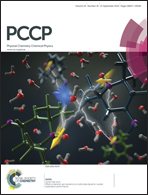Structural evolution and solvation of the OH radical in ionized water radical cations (H2O)n+, n = 5–8†
Abstract
Structural evolution of ionized water radical cations (H2O)n+, n = 5–8, is studied by ab intio methods. A structure searching method based on the previous understanding of the hydrogen bond (H-bond) network in neutral and protonated water clusters is found to be effective, covering a wide range of structural isomers of (H2O)n+. With these local minima, we can analyze both the size and temperature dependence of the structure of (H2O)n+ and solvation of the OH radical. Agreement between our calculated IR spectra and experimental data in the free OH stretching region confirms that the OH radical preferred to stay on the terminal site of the H-bond network at n = 5 and n = 6. Furthermore, we found that the OH radical began to form H-bonds with water molecules as a H-bond donor at n = 7 and 8. Vibrational signatures of fully solvated OH were found to be located at 3200–3400 cm−1 coinciding with the additional peaks found in previous experimental data obtained by Mizuse and Fujii.


 Please wait while we load your content...
Please wait while we load your content...